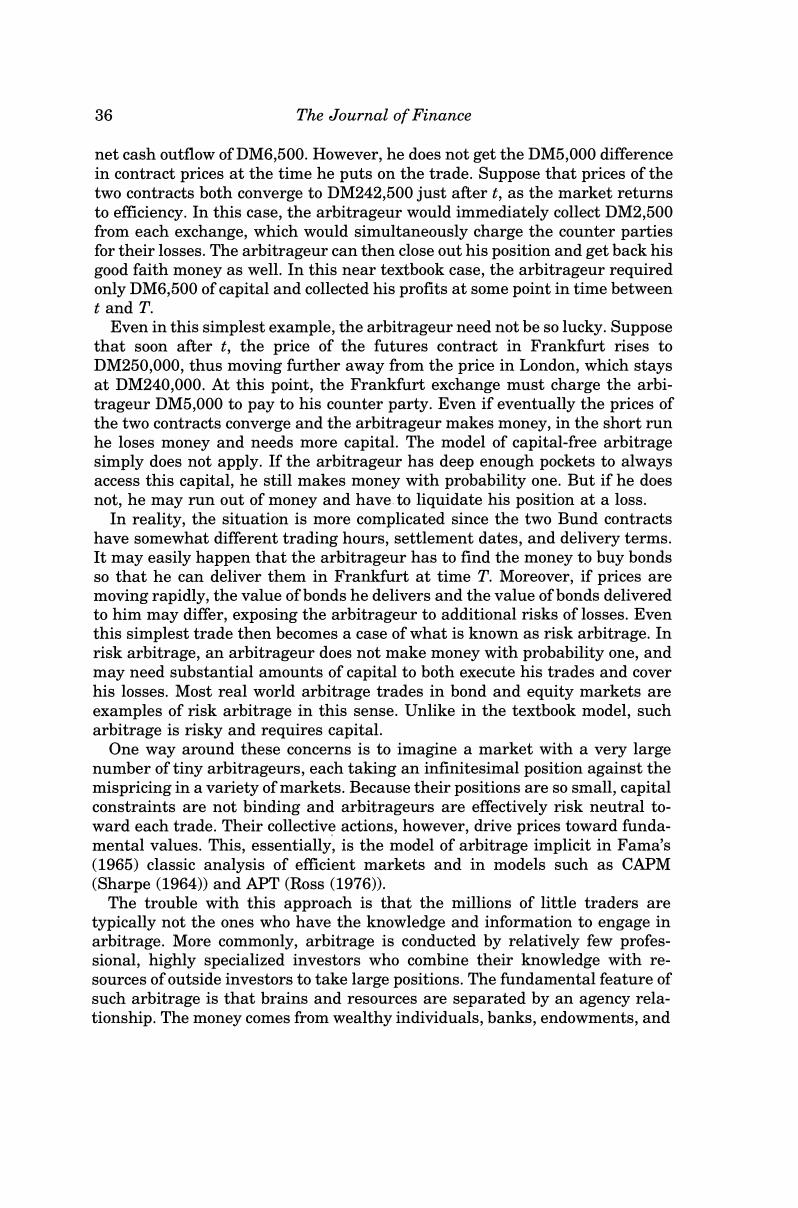正在加载图片...

36 The Journal of Finance net cash outflow of DM6,500.However,he does not get the DM5,000 difference in contract prices at the time he puts on the trade.Suppose that prices of the two contracts both converge to DM242,500 just after t,as the market returns to efficiency.In this case,the arbitrageur would immediately collect DM2,500 from each exchange,which would simultaneously charge the counter parties for their losses.The arbitrageur can then close out his position and get back his good faith money as well.In this near textbook case,the arbitrageur required only DM6,500 of capital and collected his profits at some point in time between t and T. Even in this simplest example,the arbitrageur need not be so lucky.Suppose that soon after t,the price of the futures contract in Frankfurt rises to DM250,000,thus moving further away from the price in London,which stays at DM240,000.At this point,the Frankfurt exchange must charge the arbi- trageur DM5,000 to pay to his counter party.Even if eventually the prices of the two contracts converge and the arbitrageur makes money,in the short run he loses money and needs more capital.The model of capital-free arbitrage simply does not apply.If the arbitrageur has deep enough pockets to always access this capital,he still makes money with probability one.But if he does not,he may run out of money and have to liquidate his position at a loss. In reality,the situation is more complicated since the two Bund contracts have somewhat different trading hours,settlement dates,and delivery terms. It may easily happen that the arbitrageur has to find the money to buy bonds so that he can deliver them in Frankfurt at time T.Moreover,if prices are moving rapidly,the value of bonds he delivers and the value of bonds delivered to him may differ,exposing the arbitrageur to additional risks of losses.Even this simplest trade then becomes a case of what is known as risk arbitrage.In risk arbitrage,an arbitrageur does not make money with probability one,and may need substantial amounts of capital to both execute his trades and cover his losses.Most real world arbitrage trades in bond and equity markets are examples of risk arbitrage in this sense.Unlike in the textbook model,such arbitrage is risky and requires capital. One way around these concerns is to imagine a market with a very large number of tiny arbitrageurs,each taking an infinitesimal position against the mispricing in a variety of markets.Because their positions are so small,capital constraints are not binding and arbitrageurs are effectively risk neutral to- ward each trade.Their collective actions,however,drive prices toward funda- mental values.This,essentially,is the model of arbitrage implicit in Fama's (1965)classic analysis of efficient markets and in models such as CAPM (Sharpe(1964))and APT (Ross(1976)). The trouble with this approach is that the millions of little traders are typically not the ones who have the knowledge and information to engage in arbitrage.More commonly,arbitrage is conducted by relatively few profes- sional,highly specialized investors who combine their knowledge with re- sources of outside investors to take large positions.The fundamental feature of such arbitrage is that brains and resources are separated by an agency rela- tionship.The money comes from wealthy individuals,banks,endowments,and